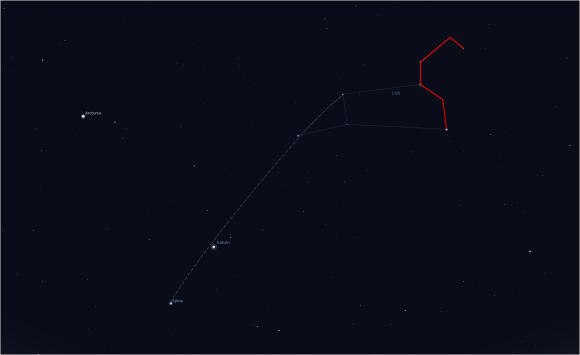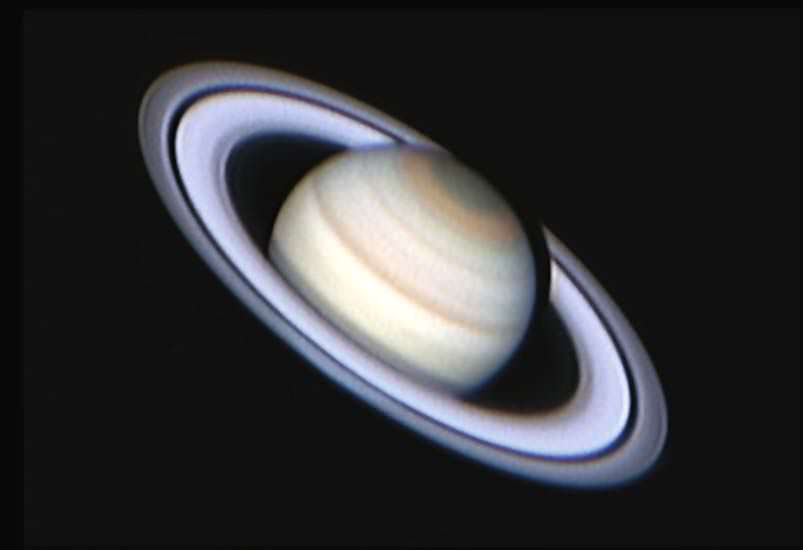If you want to find the planet Saturn in the sky this weekend, but aren’t sure where to look, this guide should help you.
Saturn is visible all night long at the moment and is quite easy to find, as it is just past opposition which makes it quite bright.

Find the constellation of Leo the Lion (high in the Southern sky at around 10pm) by looking for the backwards question mark asterism (red in the diagram), which is the head of Leo. Find the last 2 stars in Leo’s body and draw an imaginary line through these 2 stars, and arc to the left and down until you reach a bright yellowish star. This is Saturn.
If you continue drawing this imaginary line a little further you will find the bright bluish white star Spica, in the constellation of Virgo.
Right now, Saturn should be an easy target to spot with the naked eye, but looks great through binoculars and is truly amazing through any telescope.


I think that is what my new telescope needs to have its first light on. 🙂
First viewing of Saturn through my small telescope made me hooked on Astronomy. Since then I have this constant urge to proceed into astronomy.
hello there! you know, not everybody visiting universe today is knowledgable of constellations, oppositions, asterism, etc. etc. may i suggest that you use layman’s words to make it easier, for example, look east, northeast, west, northwest, etc, etc.. in this way a lot of your readers will not find it very difficult following your directions.. thank you and may the aliens guide you…
Marlon, look east look west is all relative to where you are on this planet and what time you look at.
Marlon — Not sure how much clearer “high in the Southern sky at around 10pm” plus a diagram, can be.
Would that also work for someone in Australia? Look South? 😉
nancy atkinson@ thank you mam for that simple direction. im from the philippines and i’ll try this evening as per your suggestion. I bought an astronomical telescope and binoculars in a local store here but i cannot make them work properly.
Marlon, can you give a bit more detail what does not work?
Can you tell us what telescope your have bought? A cheap one? An expensive one?
How did you test it? Did you see anything?
I took my 4″ Meade S/C out last night and took a look at Saturn and found that I don’t quite have enough aperture to see that storm? I will assume an 8″ or larger will show it visually? It was kind of hazy though, so I’ll try again tonight? But I DID see the 5 bright galaxies in Leo and M-51, The Whirlpool galaxy, with its companion for a total of 7 galaxies!
I could not see a storm. I did see some cloud bands, but the moon was too bright.
I have now a 10″. 🙂
Remember… good eyepieces and mirror alignment are key! I borrowed a friend’s $500 Nagler one night and became a believer!
April 18. Over Full Moon Spica, and over Spica Saturn. Easier it´s impossible
Hey guys I’m currently stationed in Iraq and about 8 hours ahead of the States eastern time. What time and where would I look in the night sky to see it with the naked eye? Please help!!
From Bagdad it should be in SE around 22h26 at an angle 40 degree. (if I get the timezone right) But you can download Stellarium for free, put your location and then look where it should be at that date and place.
At 01h00 AM it should be in the South at 53 degree angle SW at 03:00 AM about 42 degree angle.
Blackthought & Marlon.
You can get star charts for your location at http://www.heavens-above.com. You will need to select your city from their database, or you’ll need to supply your latitude/longitude, to get charts for your location. You will also be able to find out when specific satellites (such as the ISS) will be passing over your location.
About 10 PM local time would work… Got a got good pair of binocs? stabilized w/nite vision? Then you’ll probably also see Titan next to Saturn. Its the brightest of the Saturnian moons and appears star-like just outside of the rings. On a really good night, I’ve seen several other moons in my 4″ scope.
17 april around 01:00 AM. Saturn will be up at a 30 degree angle left from the moon center assuming that up is 0 degree. It is about 3-4 moon diameters in that direction, assuming that the moon is not too bright to see Saturn.
Now remember that location the, next day at that time, Saturn will be still there but the moon will be somewhere else.